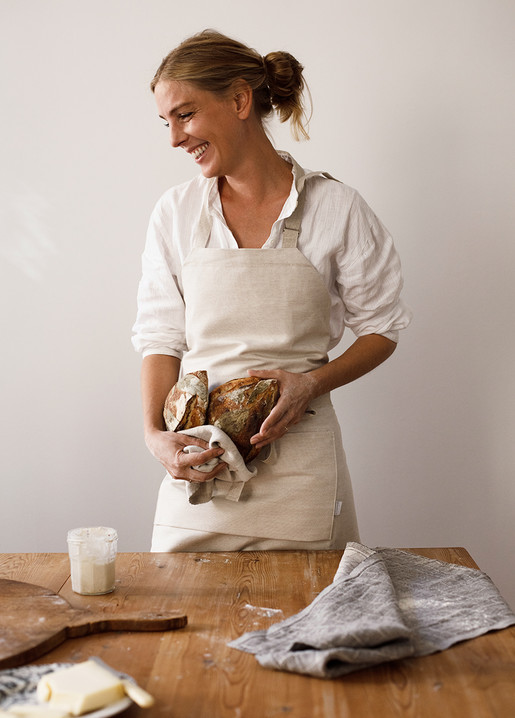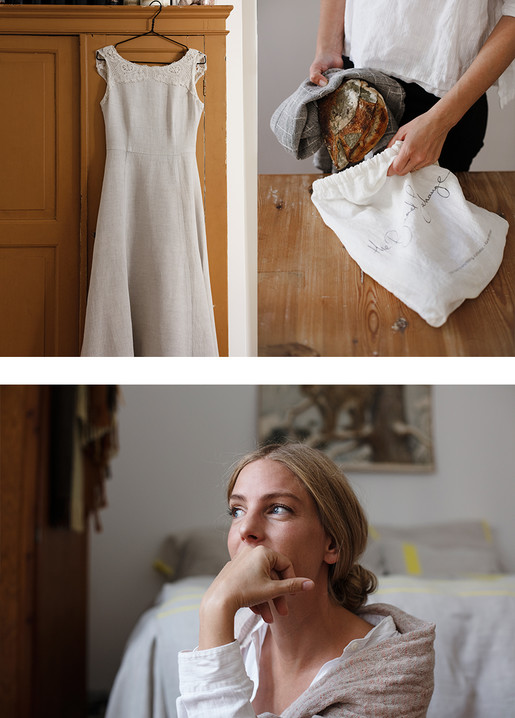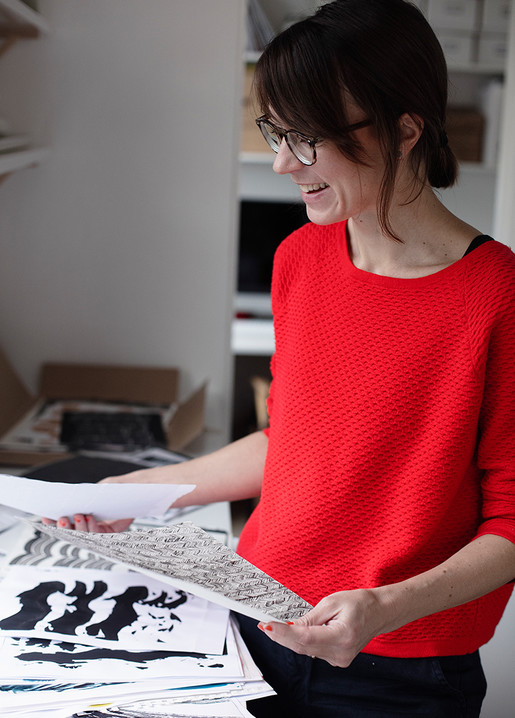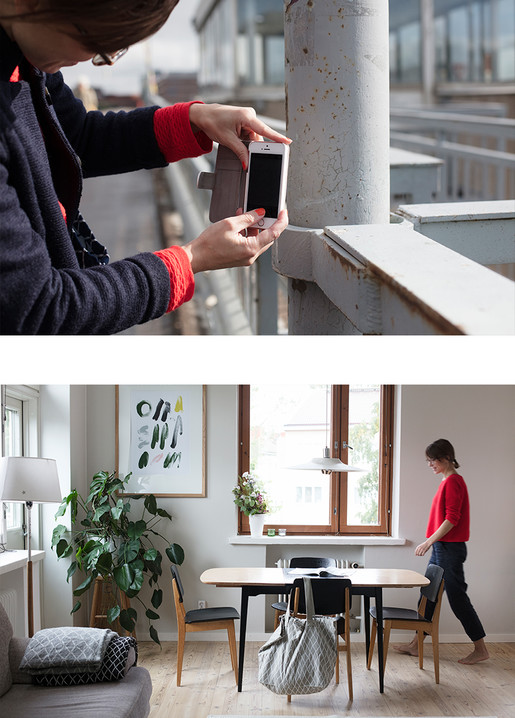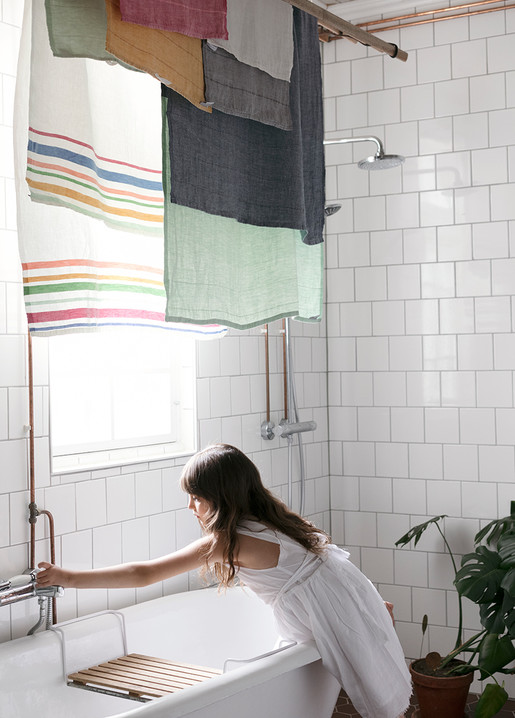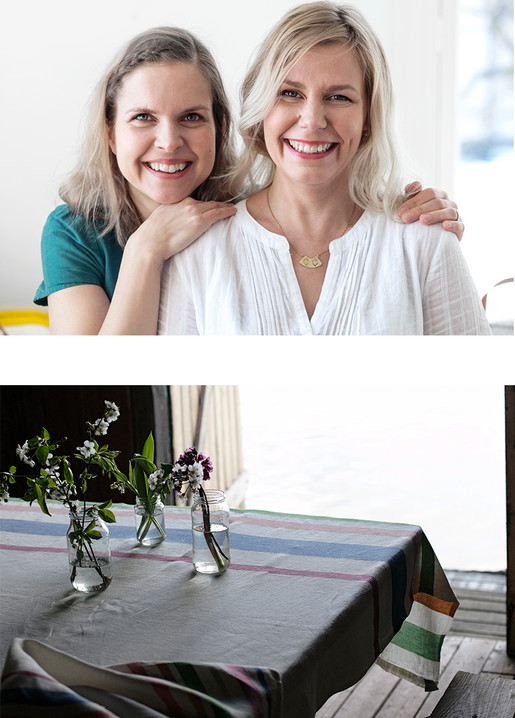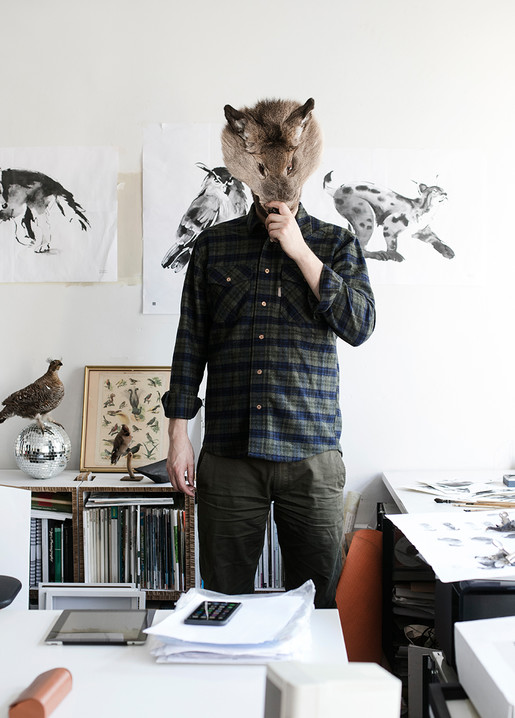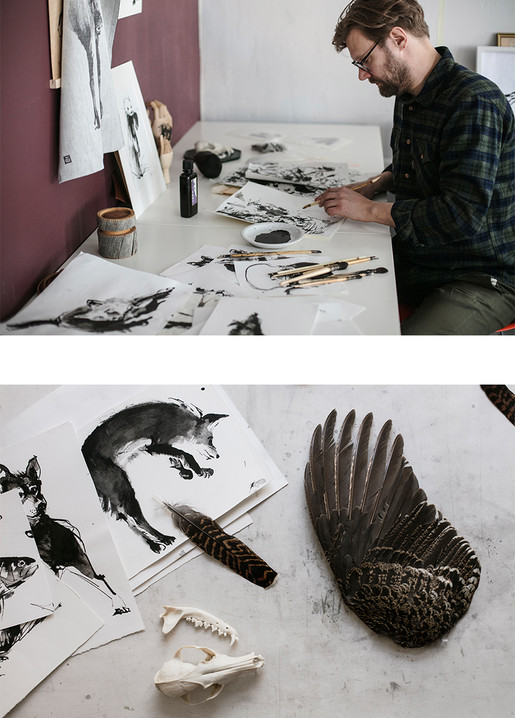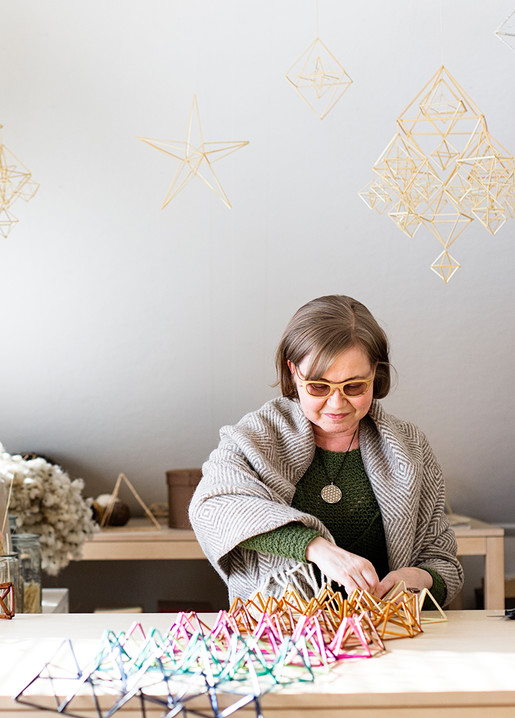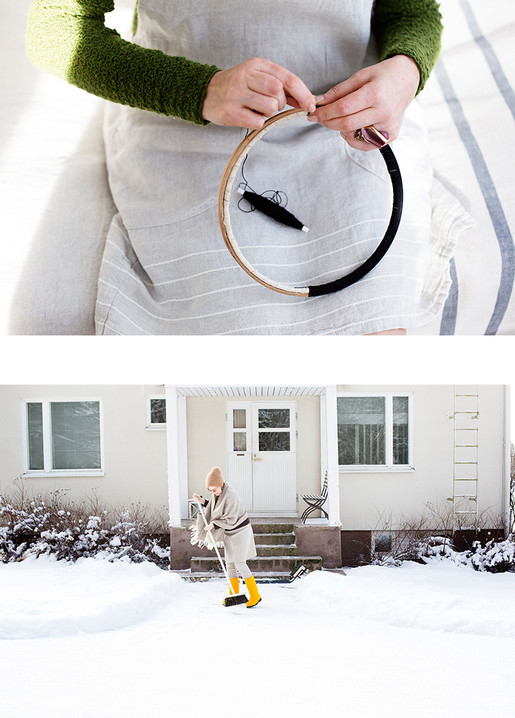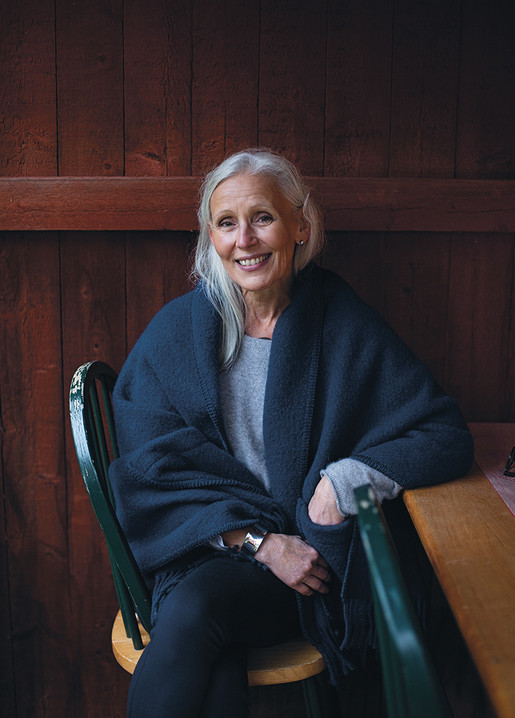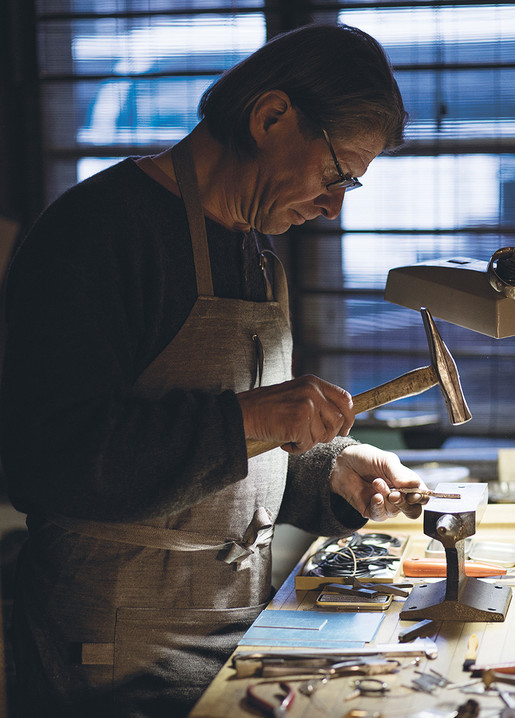Collecting Stories with Bread
Stories are always present in author and blogger Malin Elmlid's life, from baking bread to sewing clothes from authentic materials.
Malin started her project The Bread Exchange simply because, living in Berlin, she couldn't find white sourdough bread and started baking her own. "I had too much and I gave it away", she says. At first, people brought her gifts but when they started offering her money, she refused. To her, stories and people's positive energy are more interesting. "It was nice to have an area in my life that didn't involve money", Malin says. Soon, Malin started traveling around the world with her sourdough. She documents these travels on her blog The Bread Exchange. She's also written a book with the same name.
Malin's life seems to revolve around stories and a love for people. She celebrated her wedding in early autumn, and describes the day as a patchwork of all the people she's loved. She designed the wedding dress herself from Kaste linen towels woven by Lapuan Kankurit, and combined them with lace from her great aunt. "We've had our second base in Finland for two years, so it felt natural that the material came from here." Before the wedding, she took a week for herself and travelled to Bangkok to make the dress together with a familiar tailor. During the same trip, she also sewed linen shirts for her son from Lapuan Kankurit scarves. The process of making linen and wool products draws her to them. "Lapuan Kankurit tells a story through their material", she says.
History appeals to Malin and is always present in her life. She finds history flowing through everything, and if something distinctly lacks a history, she doesn't find it very interesting.
To her, history is the soul of everything. "It just makes everything more colourful", she describes. The same applies to bread. Baking with your mother's or grandmother's recipe will always be better than anything else. "All the stories of my encounters are the secret fourth ingredient of my breads", she says.
Something as simple as a loaf of bread can connect people in exceptional ways. "Bread has to be shared, because we don't finish it on our own", Malin describes.
To her, bread is a metaphor for food in general. Being invited to share a meal is a strong gesture – a friendly invitation. "Bread also plays a role in many religions, but I think it goes beyond that. Bread is the smell of home. It's the definition of home." It's hard to imagine any other item that would have so much value. "Bread can't turn against you", Malin says and lets out a warm laugh.
Her journeys have certainly taken Malin to phenomenal places and allowed her to share bread with exceptional people. To her, that means all of them. "I think that's the key to why The Bread Exchange stayed successful. I didn't capitalize it or choose who to trade with", she analyses. Each moment brings something new and inspiring to her life. "A trade with a school class can be as inspiring to me as a trade with the biggest art collector in Germany", she says. Each experience carries wonder and a constant passion for story.
1/ PANAMA MINI apron 70x80 cm, col. linen, linen-bio-organic cotton, design Lapuan Kankurit
2/ UNIQUE HANDMADE wedding dress, made of KASTE linen towels
3/ LASTU tea towel 48x70 cm, col. white-grey 100% washed linen, design Masaru Suzuki
4/ HETA scarf 65x205 cm, col. beige-orange, wool-linen, design Heta Vajavaara
Moments of Revelation
Textile designer Reeta Ek (Young Designer of the Year 2017) sees patterns in places others might overlook.
Surface, structure, rhythm. These elements are at the heart of textile designer Reeta Ek's work, and they can be found everywhere, even in the smallest of details. They are patterns on the pavement and art her children paint. "My son brought me a drawing. He'd poked the paper with a felt pen so that the colour spread", Reeta describes. He thought it might make a nice pattern – and she agreed. "The sketch is saved on my computer", she says and smiles.
As a visual person, Reeta is constantly discovering new ideas. Her computer stores hundreds of sketches that she regularly revisits to find inspiration. "You develop an intuition for what makes ideas interesting", she says. "Ultimately, it's the work itself that inspires. You have to go through many scribblings to find the one good concept." To her, any idea has the potential to grow into an intriguing design.
AALLONMURTAJA, one of Reeta's most recent designs for Lapuan Kankurit, was inspired by the Lauttasaari Bridge. She was walking around with her camera, ready to photograph anything that might stir her imagination. The wavy surface on the bridge pavement reminded her of sketches she'd made. "It was a moment of revelation, noticing that my sketches were linked to the things I saw around me." Making that new connection sparked her interest in the design. "It expressed my thinking back to me", she describes the experience.
One of Reeta's first designs for Lapuan Kankurit was TULITIKKU in 2012. Since then, she's worked together with the company on several projects and finds the work a joy. "I think every Finnish designer wants to work with them. They represent honest, down-to-earth work", she says. "It's wonderful that they weave their products in Finland."
Reeta describes her design process as part of a whole, and working with Lapuan Kankurit ensures that each step of the process works, from choosing the right materials to packaging and presenting the finished product.
Design Forum Finland recently chose Reeta as Young Designer of the Year – an honour which has since resulted in many interviews and events. Normally, her workdays consist of everything from sketching to ordering prints and answering e-mails. "If I'm sketching, I like to dedicate the day to just that", she says. Ideally, she'd reserve several days in a row for discovering new ideas. Once the sketches are done, she scans them onto her computer. Reeta says that employing technology feels like a natural part of her design process. "Adding colours helps me see the repeatable patterns the sketch could turn into." Although the computer in a pivotal part of her work, Reeta says that she always begins sketching by hand.
"I think my design process has become more precise over the years", Reeta analyses. Experience has taught her what interests her and how to focus on those elements. She also mentions that kindness towards yourself and your work is an important part of finding and maintaining inspiration. Downplaying your own ideas never works. "I hope that the more I work, the kinder I become towards myself", she says, then lets out a laugh. "I'd like to remember that things aren't always that serious."
KENIALAINEN LUONTO INNOITTAA SUOMALAISMUOTOILIJOITA
Lapuan Kankurit on aloittanut yhteistyön designyritys Mifukon kanssa keväällä 2017. Suomalaiset tekstiilitaiteilijat löytävät innoituksensa luonnosta sekä Suomessa että Keniassa.
Pohjanmaa ja Kenia kohtaavat
Yhteistyö Lapuan Kankureiden ja Mifukon välillä sai alkunsa messuilla. Mifukon perustajat Minna Impiö ja Mari Martikainen kävivät aluksi tutustumassa Kankureiden toimintaan. "Tekstiilisuunnittelijan näkökulmasta on hienoa, että Lapualla on yritys, joka valmistaa tuotteita ja on myös kansainvälinen", Martikainen sanoo. "On hienoa tehdä yhteistyötä yrityksen kanssa, jolla on samanlainen arvopohja kuin meillä." Impiö lisää, että Lapuan Kankureiden kudontatekniikka oli myös Mifukolle hieno lähtökohta työn tekemiseen. "Koen, että molemmat yritykset ovat inspiroituneet toisistaan", Martikainen täydentää.
Lapuan Kankureiden markkinointijohtaja Jaana Hjelt kertoo, että yhteistyö on avannut uusia mahdollisuuksia. "Värimaailma on erilainen, kuin mitä Kankureiden mallistossa on ennen nähty", hän sanoo. Erityisen tärkeänä Hjelt pitää Lapuan Kankureiden ja Mifukon yhteistä arvomaailmaa. "Me kaikki arvostamme aitoja asioita ja sitä, että tuotteen tekijöillä on kasvot."
Lapuan Kankureille Mifuko on suunnitellut TSAVO ja MERU -pellavamalliston, jonka designissa yhdistyvät suomalainen muotokieli ja kenialainen värimaisema. Pellavamalliston innoituksena toimivat Kenian vaihtuvat maisemat rannikoineen, ylänköineen, vuoristoineen ja savanneineen. Suunnitteluvaiheessa Impiö ja Martikainen vierailivat myös luonnonpuistossa. "Ylipäätään valo on Keniassa hyvin erilainen", Martikainen kuvailee. Kenian värien ja maisemien lisäksi myös suomalainen luonto innoittaa Mifukon tekstiilisuunnittelua. Myös yhtymäkohtia on: "Savannimaisema on oikeastaan peltomaisema, se muistuttaa Pohjanmaasta", Impiö sanoo..
Suunnittelu syntyy yhteistyönä
Tekstiilitaiteilijat Martikainen ja Impiö perustivat Mifukon vuonna 2009. Reilun Kaupan periaatteiden mukaan toimiva yritys työllistää tällä hetkellä viisisataa kenialaista käsityöläistä. Perinteisen käsityön arvostus yhdistää heitä ja Lapuan Kankureita. Impiön ja Martikaisen suunnitteluprosessi alkaa tuotteen materiaalin ja tekniikan valinnalla, minkä jälkeen he luonnostelevat ideoita paperille. "On meille ilon aihe, että suunnittelemme tuotteet yhdessä", Martikainen sanoo. "Kahdestaan pääsee helpommin eteenpäin", Impiö täydentää.
TAITEILIJA SAA LUONNOSTA VOIMAA
Taiteilija ja muotoilija Teemu Järvi on suunnitellut Lapuan Kankureille useita luontoaiheisia tuotteita vuoden 2017 mallistoon. Järven elämässä luonto on läsnä kokonaisvaltaisesti, niin innoittajana kuin työvälineiden lähteenäkin.
Luonto rauhoittumisen paikkana
Teemu Järvi on suunnitellut Lapuan Kankureille useita keittiötekstiilejä. Eläinaiheiset KETTU, PORO ja HUUHKAJA on kudottu keittiöpyyhkeisiin ja essuihin. Kaitaliina KÄPY puolestaan muistuttaa huolettomuudesta ja luonnollisuudesta. "Malli näyttää siltä, kuin pöydälle olisi rennosti ja väljästi ripoteltu käpyjä", taiteilija kuvailee. kestävä kulutus yhdistää Järven töitä ja Lapuan Kankureiden arvomaailmaa – tekstiilit on tehty kestämään sukupolvelta toiselle.
"Meillä on ollut vuosia jo myynnissä Teemun luontoaiheisia kortteja ja julisteita", kertoo Lapuan Kankureiden markkinointijohtaja Jaana Hjelt. Luonnon arvostus ja Järven intohimo työhönsä ovat hänen mukaansa erinomainen lähtökohta yhteistyölle. "Teemun luontoaiheiset kuosit istuvat loistavasti mallistoomme", Hjelt sanoo. "Tuotteillamme on aina ollut läheinen luontosuhde niin materiaaleissa, kuoseissa kuin väreissäkin."
Teemu Järvelle luonto on rauhoittumispaikka – paikka, jossa lapsenkaltainen ilo on läsnä. "Moderni kaupunkielämä muuttuu vauhdilla. Luonnossa asiat saavat perspektiivin." Luonnossa Järven ajatukset ja luovuus saavat tilaa kehittyä rauhassa. Häntä kiinnostavat myös erilaiset luontouskomukset. "Kaiken muun tekemisen kyseenalaistan, mutta luonnossa olemista en. Se tuntuu luonnolliselta ja hyvältä", hän kuvailee.
Luonto työvälineenä
Lapuan Kankureiden tuotteet on tehty aidoista luonnonmateriaaleista ympäristöä kunnioittaen. Myös Järvi käyttää luonnonmateriaaleja työvälineinään: hän piirtää ruokokynillä ja kiinantussilla. "Muuten olen kontrollifriikki, mutta rakastuin siihen, että tussin kanssa sattuma on aina läsnä", Järvi sanoo. Hän käyttää kyniensä materiaalina järviruokoa bambun sijaan. "Sillä saa vielä hienompaa jälkeä. Tuntuu siltä, että piirtää luontoa itse luonnolla."
Eija Koski – The Skymaker
The Finnish word "himmeli", which is a form of straw art, originates from the sky. People also often ask if there is something holy in himmelis. Certainly there is something in it.
The rye field waves in the summer wind, and the soft light through the leaves above makes the yard feel like a cosy nest. Only a lone swallow breaks the silence, drawing lines on the canvaslike blue sky. This very place, in the midst of Ostrobothnian plains, is an artist's dream come true.
Is there anything more beautiful than a reflection on an old shed's chalk wall? Himmelist Eija Koski's world-famous artwork hangs here; straw yellow, graphic black, even colourful. Almost three meters long, the largest one hangs noble, while the smallest one fits in a tiny box. People around the world are mad about this artwork – in Japan, Finland, the young and the old. Himmeli is not something old any more, it's trendy in modern homes, public spaces and galleries.
Passion and Purity
Also the modern, yet traditional textiles of Lapuan Kankurit feel at home here, says Eija Koski.
– There is a unique spirit in Lapuan Kankurit textiles, just as in my artwork. They embrace something very Finnish, but at the same time they are modern and express passion. I appreciate the fact that the linen textiles are made nearby, from natural ingredients.
The wool and linen products are in use also in the artist's summer cottage.
– There we sit on the porch, enjoying the sea breeze, all cuddled up in bath gowns. Natural materials feel so soft and warm.
Wild Nature
Eija Koski has always loved the nature, woods and its offerings. In her atelier, she also arranges courses on wild herbs and mushrooms. Organic flour from the surrounding fields is sold in brown paper bags. – We also run an organic farm, and it is just fabulous to follow the seasons: how the nature awakens in the spring and how the sprouts turn into crop. When the dusk falls, all kinds of wild animals visit our yard – even moose. I often ride my bike to pick mushrooms in the woods. The wild nature is so wonderful; the universal laws of beauty are still visible.
Universal Beauty
Why is it that himmeli touches people around the world?
– First I thought that it is the material, rye, which is considered the king of grain.
– For me, beauty equals harmony. I found Plato's idea that there is eternal beauty, which consists of lines and mathematical patterns. And there it was: himmeli actually is an octahedron, one of the five basic solids. Now I understand why himmeli is so widely considered beautiful.
– I often think how lucky I am having the privilege of working with nature and creating pure beauty, touching souls. I have turned my passion into a profession.
Authenticity That Spans Generations
The foggy fields welcome the visitor into Johanna Talso and Juha Koskela's home. The surroundings seem to celebrate the couple whose artisanal lifestyle is built on the appreciation of nature and tradition.
Johanna organises an annual craft fair where artisans and customers meet in 18th century historical surroundings, and sews historically accurate clothing from linen fabrics. "I grew up on a farm, so the landscape of my soul is a field," Johanna says.
When duty calls, Johanna doesn't count the hours. Ideas follow her everywhere she goes, and she sees that as a blessing. "An artisan's mind works differently," Johanna says and laughs. "We're a little weird like that." Her husband Juha Koskela is an awarded goldsmith, so craftsmanship is always present in their life.
Timeless, long-lasting materials and products have a special role in Johanna's life. She appreciates design and objects that endure. "They're not confined to present moment," she says. Textiles that can be passed down to future generations are valuable to her. In fact, she reveals that she still has some of the original linens designed by the world-renowned textile artist Dora Jung in the 1960s. The beauty of the linens hasn't faded over time. Lapuan Kankurit is currently reviving Jung's designs according to the original drawings and instructions, proving that their elegance really does span generations.
Johanna uses authentic materials, because they look and feel right. She sews clothing from Lapuan Kankurit linen fabrics, and Juha uses precious metals in his jewellery. "Tradition, history, nature, and authenticity all go hand in hand," Johanna says. The couple agrees that they didn't understand the significance of traditions when they were younger. "Now those strong values are more present in Finnish culture", Juha analyses. Johanna says that her family has always saved fun, beautiful, or handmade items. "I have my great-grandmother's linen tablecloths, and they're still in great condition," she smiles. She hopes that families continue to pass down items that are made to stand the test of time.
While craftsmanship is valued in Finland and all over the world, it still remains a marginal phenomenon. "Is it a trend to value craftsmanship, or is it really valued?" Johanna wonders. The pricing of handmade crafts is still occasionally debated. However, trendsetting magazines have also started to introduce artisanal products. "Crafts will always compete with mass-produced items," Juha adds. He's noticed that people also value individuality, and that's when trendy labels don't matter: "People want to create their unique appearance with clothing and jewellery." Johanna and Juha don't seem worried about craftsmanship disappearing altogether. "It'll always be there, sometimes stronger and sometimes weaker," Juha says. "They're appreciated more, because people don't make crafts themselves anymore."
As craftswoman and organiser of the 18th century craft fair, Johanna has experiences both sides of the artisanal community. It might be a small group of people, but special at that: "The artisanal community is close-knit," she smiles. Juha agrees. "There's a small group of people who don't want to fit in," he says, "and that's what we call craftsmanship."
Sivut


